
To Marianne Amodio, principal at MA+HG Architects, social density is at the core of savvy housing construction.Mychaylo Prystupa/The Globe and Mail
Affordability is the single greatest housing challenge facing Canada today.
That’s according to speakers at the second instalment of The Globe and Mail’s three-part National Housing Innovation Series. For panelists at the Feb. 13 event, which took place on the traditional territory of the Musqueam, Squamish and Tsleil-Waututh nations, it’s a challenge that can be solved by increasing density, smart design and community-oriented architecture.
But designing for community is not straightforward in a place with limited land mass such as Vancouver, where 91 per cent of residential housing and 99 per cent of its value is in private hands, Mayor Kennedy Stewart said in his greeting remarks.
Architects and planners would be wise to take notes on the Squamish Nation’s Senakw Lands, which sets a strong example of community-oriented design, according to Khelsilem Tl’akwasikan, elected councillor of the First Nation and presenter at the event.
Eleven towers with 6,000 housing units – 70 to 90 per cent of them rental – and commercial and retail venues are currently being built on traditional Squamish territory in Vancouver’s Kitsilano neighbourhood. Sustainable, long-term economic development for the First Nation is a driving goal, but there’s more to the ambitious project than that.
Mr. Tl’akwasikan said the project, while ground-breaking and innovative, aims to articulate Squamish values and principles through design.
“The Squamish people care very much about the environment ... they care very much about the quality of community that we build and also the type of space we create for our community,” he said during his talk on density and affordability.
For example, the community’s residential buildings will be built around a communal area of green space to be used by locals and visitors alike.
“Out of the 10-and-a-half acres, almost 80 per cent of it would be retained as communal space,” Mr. Tl’akwasikan said, adding that Senakw is designed to be “a park-activated space with different amenities to create a very lively, active community.”
One hundred per cent of taxation revenue from Senakw – which would normally be directed to a municipality – will go back to Squamish Nation to be invested into education, culture, health care, elder care and housing.
“This becomes a prototype, an example of what’s possible when we think bold and we design big, and maybe it starts to break the glass ceiling on the conversation around what should be done around housing and density,” Mr. Tl’akwasikan said.

Jennifer Keesmaat, CEO of The Keesmaat Group, says building affordable housing doesn’t mean sacrificing smart design.Mychaylo Prystupa/The Globe and Mail
For speaker and architect Marianne Amodio and her firm, MA+HG Architects, addressing Vancouver’s affordability issues starts with a focus on “social density.” The psychological term describes density as both the number of people and the number of interpersonal interactions that are likely to happen in a given setting.
“We want to participate in a culture that creates community through the sharing of spaces, and that relies on maximum human interaction for feelings of joy and belonging,” she said during her talk on designing strong neighbourhoods. “By focusing on sociability and sharing, we can show how this can improve the character of the community at large.”
While family size has decreased more than 25 per cent over the past 30 years, the size of new homes has increased by about 50 per cent, Ms. Amodio said. “It’s our role as architects to demonstrate to community members that design based on community and shared living and connectivity is in and of itself the storied return to the way things used to be.”
Mazyar Mortazavi, president and chief executive of Toronto development company TAS, said architecture and building design must reflect a community’s identified needs.
“Unless we begin to think about what happens within our buildings, designing the outside and the aesthetic is not a solution to problems,” Mr. Mortazavi said in discussion with The Globe and Mail’s Wendy Cox. “A deep focus around our work is thinking about the kinds of communities we want.
“Single-family housing is the most discriminatory kind of construct in the urban environment,” he added. “It is about privilege. As we begin to turn the conversation into a qualitative, experiential one, all of a sudden, you’re no longer talking about single-family homes. You begin to talk about the kind of place people want to live.”
Affordability is inextricably linked to social connection, agreed Charles Montgomery, founding principal of Happy City, an urban planning and design consultancy based in Vancouver.
As rates of isolation climb, pro-social environments can reduce living expenses by deepening relationships between residents. For instance, he said co-housing members in Vancouver can save up to $1,500 a month on child care by forging connections with neighbours who can help out with their kids.
“The housing form most associated with loneliness and feelings of being crowded at the very same time are residential towers,” he said during his talk on building for social well-being.
“That isn’t to say we need to stop building them, but we need to start doing something differently. It’s the soft social spaces – not your bunker-like amenity rooms – where relationships often begin.”
CMHC executive director Evan Siddall said he’s heartened by progressive new approaches to housing that address systemic issues, a shift in thinking that’s supported by the federal government’s first National Housing Strategy.
Among the organization’s priorities is urban, rural and northern housing for Indigenous people. “We’re unified around a single vision: By 2030, everyone in Canada will have a home they can afford and that meets their needs,” Mr. Siddall said.
But crucially, achieving this widespread affordability need not come at the cost of savvy design, said Jennifer Keesmaat, founder of the Keesmaat Group.
“If design is about human dignity,” she said, “when we’re talking about affordability, design ought to be at the fore about how we think about delivering housing for all in our country.”